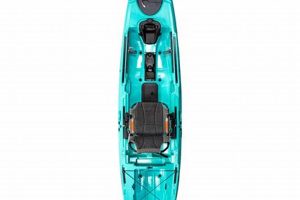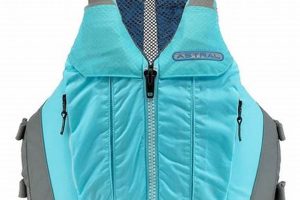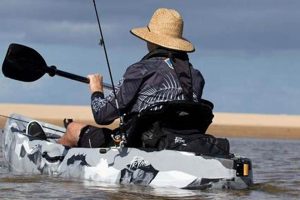This angling method involves using living creatures as attractants to lure fish from a kayak. Common bait choices include minnows, worms, and crustaceans, depending on the target species. An example would be using small shrimp to attract redfish in shallow estuaries from a maneuverable, paddle-powered vessel.
Fishing from a kayak with live bait offers a stealthy approach, allowing anglers to access shallow or heavily vegetated areas often inaccessible to larger boats. This quiet approach, combined with the natural presentation of live bait, can significantly increase the chance of a successful catch. Historically, small watercraft and natural baits were staples of fishing practice, demonstrating the enduring effectiveness of this combined method in modern angling.
This article will explore the various facets of this popular angling technique, covering topics such as selecting appropriate bait for different species, rigging and presentation techniques, ideal kayak features for this style of fishing, responsible bait handling practices, and recommended locations.
Tips for Successful Kayak Fishing with Live Bait
Effective angling from a kayak using live bait requires careful planning and execution. The following tips offer guidance for a productive and enjoyable experience.
Tip 1: Match the Hatch. Bait selection should reflect the target species’ natural diet. Researching local fish populations and their preferred prey is crucial.
Tip 2: Prioritize Kayak Stability. A stable kayak platform is essential for managing live bait, tackle, and landing fish. Wider, sit-on-top kayaks are often preferred.
Tip 3: Employ Appropriate Rigging. Rigging should complement the bait and target species. Consider using circle hooks to minimize injury to the fish, promoting catch and release practices.
Tip 4: Manage Bait Properly. Keeping bait alive and vigorous is key to success. Aerated bait wells or containers are recommended for longer trips.
Tip 5: Understand Water Depth and Current. Fish behavior is influenced by these factors. Positioning the kayak strategically for optimal bait presentation is crucial.
Tip 6: Practice Stealth. Kayaks offer a quiet approach. Avoid sudden movements or excessive noise that could spook fish.
Tip 7: Respect Local Regulations. Adhere to all licensing requirements and regulations regarding bait usage and fish size/bag limits.
By following these tips, anglers can maximize their chances of a successful and rewarding kayak fishing experience with live bait. Preparation and understanding of the environment contribute significantly to positive outcomes.
These insights provide a solid foundation for approaching this dynamic angling method. The following section will offer concluding thoughts and further resources for continued learning.
1. Bait Selection
Bait selection stands as a cornerstone of successful live bait kayak fishing. The choice of bait directly influences the species attracted and the overall effectiveness of the fishing expedition. Different fish species exhibit varying feeding preferences, influenced by factors such as habitat, water temperature, and prey availability. A mismatch between bait and target species can lead to minimal or no catches, underscoring the critical nature of informed bait selection. For instance, using freshwater minnows in a saltwater environment targeting flounder would likely prove ineffective, while mud minnows might prove successful. Conversely, using saltwater shrimp in a freshwater lake for bass would be unproductive, whereas nightcrawlers would likely yield better results. Matching the bait to the target species’ dietary preferences is paramount.
Effective bait selection necessitates research and an understanding of local ecosystems. Anglers benefit from consulting local bait shops, experienced kayak anglers, or online resources to determine prevalent forage species in their target fishing area. Observing the natural environment can also provide valuable insights. The presence of certain insects, crustaceans, or smaller fish can indicate the preferred diet of larger predatory fish. This knowledge empowers anglers to choose bait that closely mimics the natural prey, increasing the likelihood of attracting the target species. For example, in areas with abundant small crabs, using live crabs as bait can prove highly effective for attracting sheepshead or redfish.
In summary, strategic bait selection significantly amplifies the effectiveness of live bait kayak fishing. This practice involves careful consideration of the target species, local ecosystems, and prevalent forage. Aligning bait choice with these factors optimizes the chances of a successful catch, maximizing the rewards of this specialized angling technique. Ignoring this crucial aspect can significantly hinder fishing success, highlighting the intimate connection between bait selection and achieving desired outcomes in live bait kayak fishing. This understanding emphasizes the importance of preparation and knowledge in maximizing the effectiveness of this angling approach.
2. Kayak Stability
Kayak stability plays a crucial role in live bait kayak fishing, directly impacting an angler’s ability to manage bait, tackle, and landed fish effectively. A stable platform minimizes the risk of capsizing, especially during critical moments such as baiting a hook, fighting a fish, or landing a catch. These activities often require intricate movements and shifts in weight distribution, potentially compromising balance. An unstable kayak can hinder these actions, increasing the likelihood of losing fish, tangling lines, or even ending up in the water. For example, attempting to unhook a feisty fish in a narrow, unstable kayak can easily lead to an accidental capsize, while a wider, more stable platform allows for greater control and reduces this risk.
Various factors influence kayak stability, including hull design, width, and length. Wider kayaks generally offer greater initial stability, making them ideal for activities requiring frequent movement and weight shifting, such as live bait fishing. Longer kayaks tend to track straighter and offer better speed, but they can be less maneuverable and less stable initially. Hull design also contributes significantly to stability. Flat-bottomed hulls provide excellent initial stability, making them suitable for calm waters and activities like fishing. V-shaped hulls, while offering better tracking and performance in rougher conditions, compromise initial stability. Choosing a kayak with appropriate stability features tailored to the demands of live bait fishing significantly enhances the overall experience and contributes to a safer and more productive outing. For instance, a wider, flat-bottomed kayak provides a secure platform for managing live bait containers, allowing anglers to focus on fishing rather than constantly battling to maintain balance.
Understanding the connection between kayak stability and live bait fishing enables informed decisions regarding kayak selection and on-the-water practices. Recognizing the importance of a stable platform allows anglers to choose kayaks with suitable characteristics, leading to increased confidence, improved fishing performance, and enhanced safety. Furthermore, understanding the impact of stability on various fishing activities encourages careful weight distribution and deliberate movements while on the water. This awareness minimizes the risk of capsizing and allows for more efficient bait management, hook setting, and fish landing. Ultimately, prioritizing kayak stability translates to a more enjoyable, productive, and safer live bait kayak fishing experience. It allows anglers to focus on the nuances of fishing rather than constantly battling balance issues, ultimately contributing to a more successful and fulfilling outing.
3. Rigging and Presentation
Rigging and presentation represent crucial elements within live bait kayak fishing, significantly influencing fishing success. Effective rigging ensures the bait remains lively and appealing while maximizing hook-up potential. Proper presentation enhances the bait’s natural appearance and movement, enticing target species to strike. The interplay of these two factors directly impacts catch rates, underscoring their importance in this angling technique.
- Hook Selection
Hook selection depends on the target species and bait size. Using excessively large hooks can hinder the bait’s natural movement and deter fish. Conversely, using hooks too small can result in missed strikes and lost fish. Circle hooks, known for their ability to hook fish in the corner of the mouth, minimize injury and promote catch and release practices. For example, when targeting smaller panfish with live worms, a small #6 or #8 hook would be appropriate, while larger species like bass or catfish might require a larger #1 or 1/0 hook. Proper hook selection ensures effective hooking while minimizing harm to the fish.
- Weight and Leader
Weight and leader choices depend on water depth, current, and target species. In deeper water or strong currents, heavier weights are necessary to keep the bait at the desired depth. Lighter weights are preferable in shallow, calm waters. Leader material, such as fluorocarbon or monofilament, impacts visibility and abrasion resistance. Fluorocarbon, due to its low visibility, is often preferred in clear water scenarios. For instance, fishing for flounder in a shallow bay might require only a split shot weight and a light fluorocarbon leader, while fishing for snapper in deeper offshore waters necessitates heavier weights and potentially a wire leader to prevent bite-offs.
- Bait Presentation Techniques
Different bait presentation techniques cater to specific species and fishing conditions. Drift fishing allows the bait to move naturally with the current, covering a wider area. Anchoring and casting allows for targeted presentation near structures or cover. Trolling involves slowly dragging the bait behind the kayak, covering a larger area and simulating the movement of prey. For example, drifting live shrimp along a grassy shoreline can be effective for targeting redfish, while anchoring and casting live bait near a submerged log can attract largemouth bass.
- Depth Control
Controlling bait depth is critical for presenting the bait within the target species’ strike zone. Bobbers or floats suspend bait at a specific depth, while slip bobbers or sliding floats allow for fishing at varying depths. Adjusting line length and weight allows for fine-tuning bait depth to match the fish’s feeding habits. For example, when targeting crappie suspended over deep water, a slip bobber rigged to present the bait just above the thermocline can be highly effective, while fishing for bottom-dwelling catfish might require a simple weight rig to keep the bait near the bottom.
Mastering rigging and presentation techniques in live bait kayak fishing directly translates to increased angling success. These interconnected elements work in concert to enhance bait presentation, attract target species, and secure solid hooksets. By understanding the nuances of hook selection, weight and leader choices, presentation methods, and depth control, anglers can significantly improve their catch rates and overall fishing experience. The ability to adapt these techniques to specific fishing conditions further distinguishes skilled kayak anglers, demonstrating the importance of knowledge and adaptability within this specialized fishing discipline.
4. Location and Environment
Location and environment represent critical factors in live bait kayak fishing, directly influencing species presence, behavior, and feeding patterns. Understanding the interplay between these elements and fish ecology is essential for maximizing angling success. Water temperature, clarity, depth, current, and the presence of structures such as vegetation, rocks, or submerged debris all play significant roles in determining where fish congregate and how they respond to presented bait. For example, cold-water species like trout prefer clear, oxygen-rich streams and rivers, while warm-water species like bass thrive in slower-moving, vegetated areas of lakes and ponds. Choosing a location based on target species’ environmental preferences significantly increases the probability of encountering them. Ignoring these factors can lead to unproductive fishing trips, highlighting the importance of understanding the target species’ habitat requirements.
Tidal influence also plays a crucial role in saltwater environments. Incoming tides often bring baitfish and other prey closer to shore, attracting larger predatory fish. Outgoing tides can concentrate fish in channels and deeper holes as water recedes. Understanding tidal patterns allows anglers to strategically position themselves for optimal bait presentation. For instance, fishing near inlets or estuaries during an incoming tide can be highly effective for targeting species like redfish or snook as they ambush prey swept in by the current. Similarly, fishing deeper channels during an outgoing tide can produce catches of flounder or speckled trout seeking refuge from the receding water. Adapting fishing strategies to tidal fluctuations is essential for maximizing success in saltwater kayak fishing.
Successful live bait kayak fishing requires a comprehensive understanding of the target species’ preferred environment and how environmental factors influence their behavior. This knowledge allows anglers to select locations with higher probabilities of fish presence and tailor bait presentation to match prevailing conditions. Observing natural indicators such as baitfish activity, bird behavior, and water movement can further refine location choices and increase catch rates. Ultimately, recognizing the profound impact of location and environment enhances angling success and promotes a deeper appreciation for the interconnectedness of aquatic ecosystems. This understanding transforms kayak fishing from a simple pastime into a more informed and rewarding pursuit, emphasizing the importance of environmental awareness in achieving angling objectives.
5. Safety and Regulations
Safety and regulatory compliance are paramount in live bait kayak fishing, ensuring angler well-being and promoting responsible environmental stewardship. Overlooking these aspects can jeopardize personal safety and negatively impact aquatic ecosystems. Understanding and adhering to relevant regulations and prioritizing safe practices contribute significantly to a sustainable and enjoyable fishing experience.
- Personal Flotation Devices (PFDs)
Wearing a PFD is crucial for kayak fishing safety. Unforeseen circumstances, such as capsizing or unexpected weather changes, can create hazardous situations. A PFD provides essential buoyancy, increasing the chances of survival in the event of an accident. Selecting a comfortable, well-fitting PFD designed for paddling activities ensures unrestricted movement while providing adequate flotation. Regularly inspecting PFDs for damage and proper function is also essential for maintaining their effectiveness.
- Navigation and Communication
Carrying a navigational aid, such as a GPS device or chart, is vital, particularly in unfamiliar waters. These tools assist in maintaining orientation and prevent disorientation, especially in adverse weather conditions or low visibility. A communication device, such as a VHF radio or waterproof cell phone, allows for emergency contact in case of distress or unexpected events. Informing someone of planned fishing locations and estimated return times further enhances safety protocols, ensuring timely assistance if needed.
- Licensing and Regulations
Obtaining the necessary fishing licenses and adhering to local fishing regulations are crucial components of responsible angling. Regulations often dictate size and bag limits for specific species, protecting fish populations and promoting sustainable fishing practices. Understanding and complying with these regulations ensures the longevity of fish stocks and the overall health of the aquatic ecosystem. Consulting local authorities or online resources provides access to current regulations and licensing requirements.
- Bait Handling and Disposal
Proper handling and disposal of live bait minimize environmental impact. Introducing non-native bait species can disrupt local ecosystems and potentially harm native fish populations. Using locally sourced bait minimizes this risk. Disposing of unused bait responsibly prevents the spread of invasive species and maintains the integrity of the environment. For example, never release unused bait into a waterway; instead, dispose of it in a sealed container or designated disposal area.
Prioritizing safety and regulatory compliance enhances the overall live bait kayak fishing experience. Adhering to these principles promotes angler well-being, protects the environment, and ensures the sustainability of fish populations. By integrating these practices, anglers contribute to the responsible enjoyment of this dynamic and rewarding angling method, demonstrating respect for both the sport and the natural world.
Frequently Asked Questions
This section addresses common inquiries regarding live bait kayak fishing, providing concise and informative responses to enhance understanding and promote best practices.
Question 1: What are the most effective live baits for kayak fishing?
Effective live baits vary depending on target species and location. Commonly used options include minnows, worms, shrimp, and crabs. Researching local fish preferences is crucial for optimal bait selection.
Question 2: What type of kayak is best suited for live bait fishing?
Stable kayaks, particularly wider sit-on-top models, are recommended for live bait fishing. Stability facilitates bait management, fish handling, and overall safety.
Question 3: How should live bait be stored and maintained during a kayak fishing trip?
Live bait requires proper storage to maintain its viability. Aerated bait wells, buckets, or specialized containers enhance bait longevity. Keeping bait cool and minimizing stress are crucial.
Question 4: Are there specific regulations concerning live bait usage?
Regulations regarding live bait vary by location. Some areas restrict the use of certain species or impose limits on bait quantities. Consulting local fishing regulations is essential for compliance.
Question 5: What safety precautions should be considered when kayak fishing with live bait?
Wearing a personal flotation device (PFD) is paramount. Informing someone of fishing plans, carrying a communication device, and being aware of weather conditions are essential safety measures.
Question 6: How does one locate productive fishing spots from a kayak?
Identifying productive fishing locations involves understanding fish behavior and habitat preferences. Look for areas with structure, such as vegetation, rocks, or drop-offs, which often attract fish.
Understanding these key aspects of live bait kayak fishing contributes to a safer, more productive, and environmentally responsible angling experience. Preparation and knowledge enhance enjoyment and promote sustainable fishing practices.
This concludes the frequently asked questions section. The following section will offer concluding remarks.
Live Bait Kayak Fishing
This exploration of live bait kayak fishing has highlighted the multifaceted nature of this angling technique. From bait selection and kayak stability to rigging, presentation, location awareness, and safety considerations, each component contributes significantly to a successful and rewarding experience. The interplay of these factors underscores the importance of a holistic approach, demanding preparation, knowledge, and adaptability from anglers. Strategic bait selection, tailored to target species and local ecosystems, maximizes effectiveness. Kayak stability ensures efficient bait and line management, contributing to both safety and angling success. Rigging and presentation techniques, adapted to specific conditions and target species, enhance hook-up rates and promote ethical fishing practices. Understanding the influence of location and environment on fish behavior is crucial for identifying productive fishing spots. Finally, prioritizing safety and adhering to regulations ensure angler well-being and contribute to the sustainability of aquatic resources.
Live bait kayak fishing offers a unique and engaging way to connect with the natural world. The combination of a stealthy approach, natural bait presentation, and access to diverse aquatic environments provides rewarding angling opportunities. However, the effectiveness of this technique relies heavily on responsible practices and a deep understanding of fish behavior and aquatic ecosystems. Continued learning, adaptation to specific conditions, and a commitment to ethical angling practices are essential for maximizing the enjoyment and long-term sustainability of live bait kayak fishing. This approach ensures not only personal angling success but also the preservation of these valuable natural resources for future generations.






